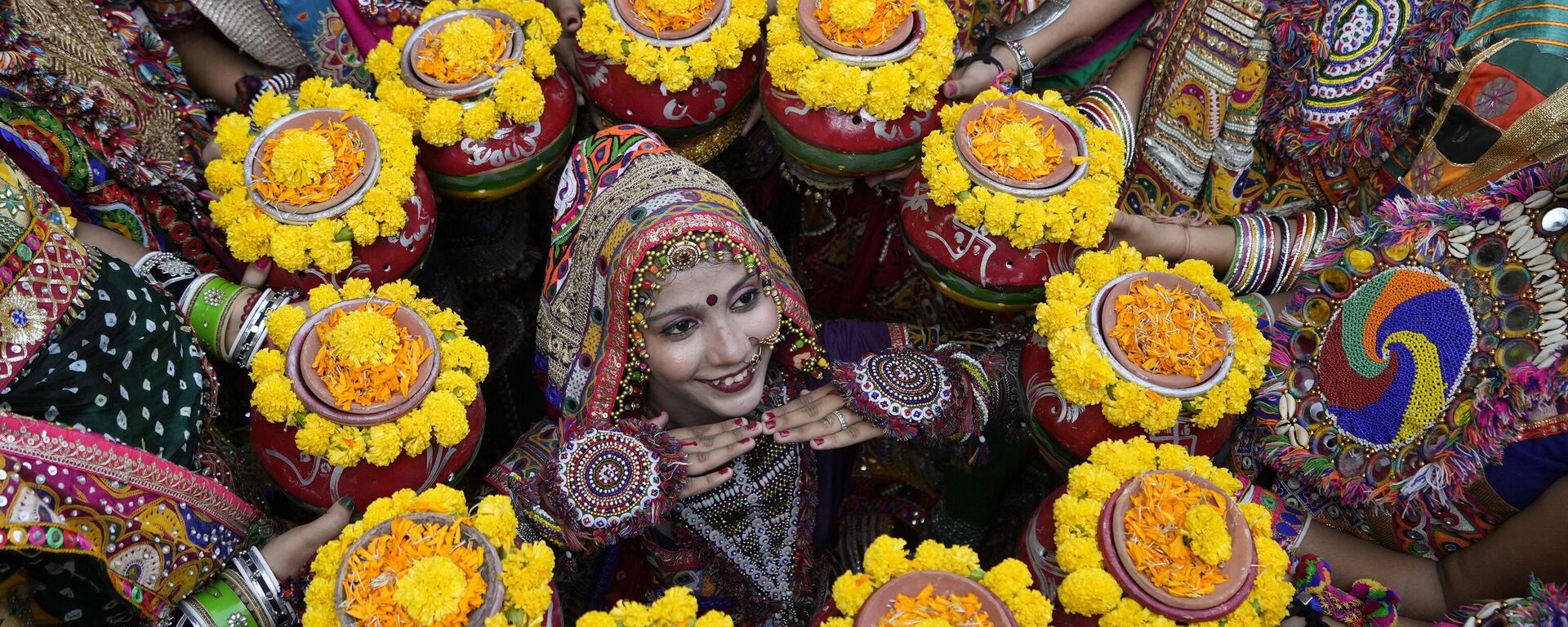https://sputniknews.in/20231031/step-by-step-guide-for-married-women-to-celebrate-karwa-chauth-2023-5151576.html
Step-by-Step Guide for Married Women to Celebrate Karwa Chauth 2023
Step-by-Step Guide for Married Women to Celebrate Karwa Chauth 2023
Sputnik India
On 1 November, married or soon-to-be-married women celebrate the one-day Hindu festival of Karva Chauth by fasting rigorously and praying for the long life and good health of their husbands.
2023-10-31T16:58+0530
2023-10-31T16:58+0530
2023-10-31T16:58+0530
india
moon
hindu
hindu deities
hindu marriage
hindu goddess kali
hindu devotees
hindu festival
hindu shrine
hinduism
https://cdn1.img.sputniknews.in/img/07e7/0a/1f/5161147_0:0:400:225_1920x0_80_0_0_ac28d1b646ab930fefa75584e4272ea0.png
Preparations are in full swing for the Hindu festival of Karwa Chauth, when married or soon-to-be-married Hindu women observe a rigorous fast, abstaining from water and food throughout the day and praying for the longevity of their husbands.From observing 'nirjala vrat' (fasting without water and food), dressing up in a red saree or lehenga, applying henna on the hands, wearing jewellery, sindoor (cinnabar), singing and reciting the story of Karwa Chauth and breaking the fast at moonrise, the festival of Karwa Chauth has its own charm.Sputnik India tells you how married and soon-to-be-married women celebrate Karwa Chauth.Auspicious Time (Muhurat) for PujaKarwa Chauth, also known as Karaka Chaturthi, is derived from two words - Karwa, which means earthen pots, and Chauth, which means the fourth day of the lunar month.This year, the festival falls on Wednesday, 1 November.According to the Hindu calendar Drik Panchang, the auspicious time of Karwa Chauth starts on Tuesday night at 9:30 p.m. IST and concludes on Wednesday at 9:19 p.m.The fasting (vrat) time is from 6:33 a.m. to 6:15 p.m., and the moonrise time is at 8:15 p.m.How Married Women Should Celebrate Karwa Chauth 2023On Karwa Chauth, married Hindu women wake up early before sunrise around 4 a.m.After bathing, women eat sargi platter (an auspicious feast prepared by their mother-in-law) before observing 'nirjala vrat', or fasting, by not taking food or even a drop of water after sunrise for the entire day.The Sargi platter consists of fruits, sweets, dry fruits, and other favourite food items.They then clean the temple at their home, light a diya, and worship Goddess Parvati, Lord Shiva, Lord Ganesha, and Lord Kartikeya, for the long life of their husbands, and family's good luck and prosperity to the family.The women then take a pledge for a nirjala vrat and listen to the Karwa Chauth story. While some strictly follow the fasting rules and refrain from consuming anything till the moon rises, others have tea or coffee after listening to the Karwa Chauth story. They dress up like a newly married bride, wearing red outfit and performing solah sringar (16 bridal ornaments) which includes wearing sindoor (vermilion), bangles, bindi, kajal, wearing traditional ornaments and others.Some other colours that can be worn on Karwa Chauth day are red, pink, yellow, green and maroon. Wearing black, brown and white colours is considered inappropriate.People also buy Karwa, a decorated earthen pot, and fill it with sweets.A delicious feast is prepared at home to offer bhog (food to God).Women break their fast only after looking at the Moon and their husbands' faces through a round mesh sift.They offer water (arghya) to the moon using an earthen pot, after which the husband breaks his wife's fast by giving her a morsel of sweets and a sip of water.The daughter-in-law also gives a baya (a gift or token of appreciation) to her mother-in-law. The baya includes money, clothes, jewellery, cosmetics, sindoor (vermilion) and sweets.The festival ends with a gala feast where people enjoy delicious food with the family.
https://sputniknews.in/20231015/how-to-fast-for-navratri-4789205.html
india
moon
Sputnik India
feedback.hindi@sputniknews.com
+74956456601
MIA „Rossiya Segodnya“
2023
Sangeeta Yadav
https://cdn1.img.sputniknews.in/img/07e6/0c/0f/110602_0:0:641:640_100x100_80_0_0_c298016a79eb02ef8caa9d1f688c12a5.jpg
Sangeeta Yadav
https://cdn1.img.sputniknews.in/img/07e6/0c/0f/110602_0:0:641:640_100x100_80_0_0_c298016a79eb02ef8caa9d1f688c12a5.jpg
News
en_IN
Sputnik India
feedback.hindi@sputniknews.com
+74956456601
MIA „Rossiya Segodnya“
Sputnik India
feedback.hindi@sputniknews.com
+74956456601
MIA „Rossiya Segodnya“
Sangeeta Yadav
https://cdn1.img.sputniknews.in/img/07e6/0c/0f/110602_0:0:641:640_100x100_80_0_0_c298016a79eb02ef8caa9d1f688c12a5.jpg
married women, soon-to-be married women, celebrate karva chauth , hindu festival karwa chauth, how to fast on karwa chauth, prayers for karwa chauth, karwa chauth story, significane of karwa chauth, when is karwa chauth, karwa chuth muhurat, pray for husband’s longevity, what is nirjala vrat, karwa chauth fasting, why wearing red on karwa chauth is significant, karaka chaturthi, earthen pots, lunar month, hindu calendar drik panchang, step-by-step guide to celebrate karwa chauth 2023, what is sargi, food to include in sargi, sargi plate, fruits, mathri, sweets, dry fruits, food items, worship goddess parvati, lord shiva, lord ganesha, lord kartikeya, fast dos and donts, moonrise, what is karwa chauth katha, newly married bride, bhog, gala feast,
married women, soon-to-be married women, celebrate karva chauth , hindu festival karwa chauth, how to fast on karwa chauth, prayers for karwa chauth, karwa chauth story, significane of karwa chauth, when is karwa chauth, karwa chuth muhurat, pray for husband’s longevity, what is nirjala vrat, karwa chauth fasting, why wearing red on karwa chauth is significant, karaka chaturthi, earthen pots, lunar month, hindu calendar drik panchang, step-by-step guide to celebrate karwa chauth 2023, what is sargi, food to include in sargi, sargi plate, fruits, mathri, sweets, dry fruits, food items, worship goddess parvati, lord shiva, lord ganesha, lord kartikeya, fast dos and donts, moonrise, what is karwa chauth katha, newly married bride, bhog, gala feast,
Step-by-Step Guide for Married Women to Celebrate Karwa Chauth 2023
On 1 November, married or soon-to-be-married women celebrate the one-day Hindu festival of Karva Chauth by fasting rigorously and praying for the long life and good health of their husbands.
Preparations are in full swing for the Hindu festival of Karwa Chauth, when married or soon-to-be-married Hindu women observe a rigorous fast, abstaining from water and food throughout the day and praying for the longevity of their husbands.
From observing 'nirjala vrat' (fasting without water and food), dressing up in a red saree or lehenga, applying henna on the hands, wearing jewellery, sindoor (cinnabar), singing and reciting the story of Karwa Chauth and breaking the fast at moonrise, the festival of Karwa Chauth has its own charm.
Sputnik India tells you how married and soon-to-be-married women celebrate Karwa Chauth.
Auspicious Time (Muhurat) for Puja
Karwa Chauth, also known as Karaka Chaturthi, is derived from two words - Karwa, which means earthen pots, and Chauth, which means the fourth day of the lunar month.
This year, the festival falls on Wednesday, 1 November.
According to the Hindu calendar Drik Panchang, the auspicious time of Karwa Chauth starts on Tuesday night at 9:30 p.m. IST and concludes on Wednesday at 9:19 p.m.
The
fasting (vrat) time is from 6:33 a.m. to 6:15 p.m., and the moonrise time is at 8:15 p.m.
How Married Women Should Celebrate Karwa Chauth 2023
On Karwa Chauth, married Hindu women wake up early before sunrise around 4 a.m.
After bathing, women eat sargi platter (an auspicious feast prepared by their mother-in-law) before observing 'nirjala vrat', or fasting, by not taking food or even a drop of water after sunrise for the entire day.
The Sargi platter consists of fruits, sweets, dry fruits, and other favourite food items.
They then clean the temple at their home, light a diya, and worship
Goddess Parvati, Lord Shiva, Lord Ganesha,
and Lord Kartikeya, for the long life of their husbands, and family's good luck and prosperity to the family.
The women then take a pledge for a nirjala vrat and listen to the Karwa Chauth story.
While some strictly follow the fasting rules and refrain from consuming anything till the moon rises, others have tea or coffee after listening to the Karwa Chauth story.
They dress up like a newly married bride, wearing red outfit and performing solah sringar (16 bridal ornaments) which includes wearing sindoor (vermilion), bangles, bindi, kajal, wearing traditional ornaments and others.
Some other colours that can be worn on Karwa Chauth day are red, pink, yellow, green and maroon. Wearing black, brown and white colours is considered inappropriate.
People also buy Karwa, a decorated earthen pot, and fill it with sweets.
A delicious feast is prepared at home to offer bhog (food to God).
Women break their fast only after looking at the
Moon and their husbands' faces through a round mesh sift.
They offer water (arghya) to the moon using an earthen pot, after which the husband breaks his wife's fast by giving her a morsel of sweets and a sip of water.
The daughter-in-law also gives a baya (a gift or token of appreciation) to her mother-in-law. The baya includes money, clothes, jewellery, cosmetics, sindoor (vermilion) and sweets.
The festival ends with a gala feast where people enjoy delicious food with the family.



